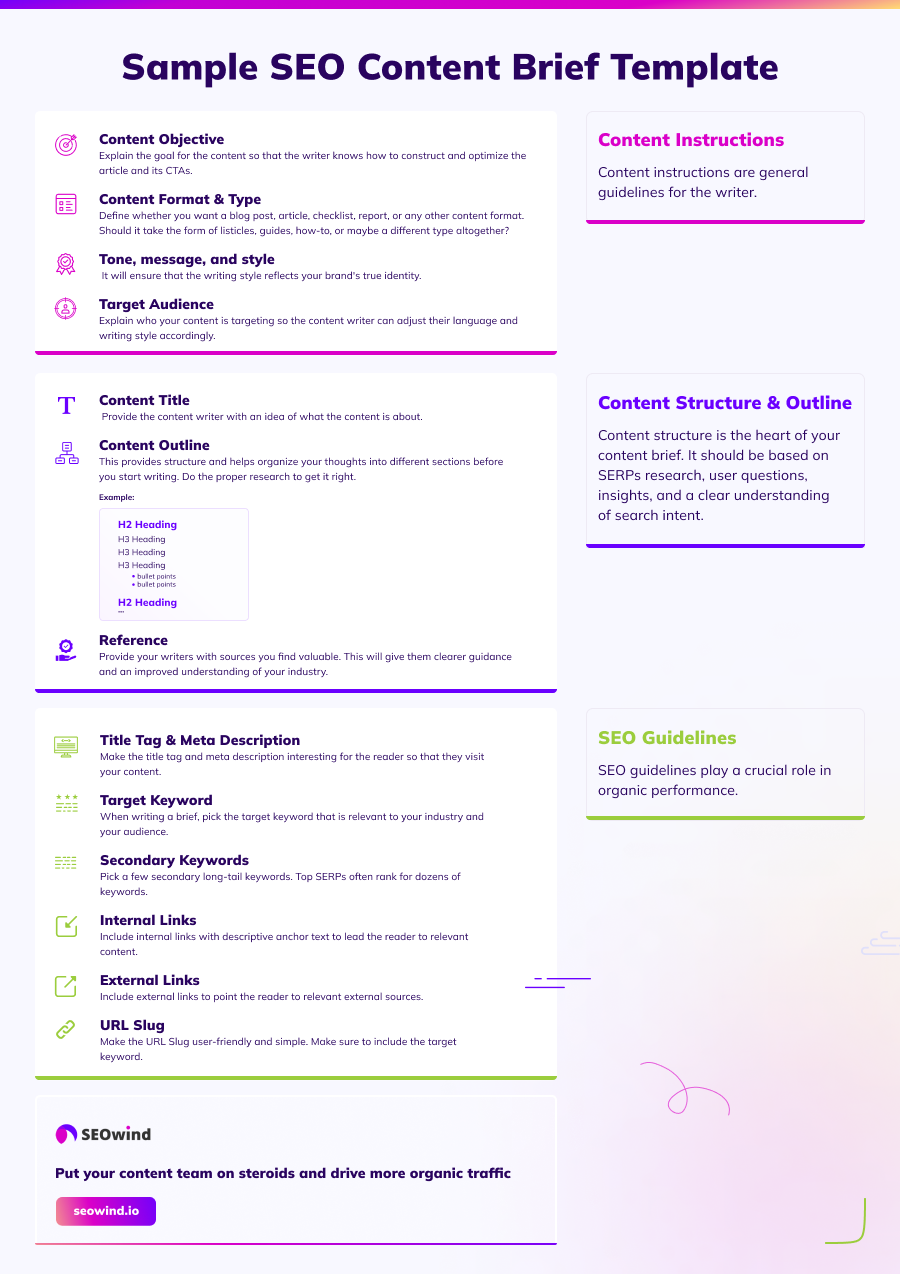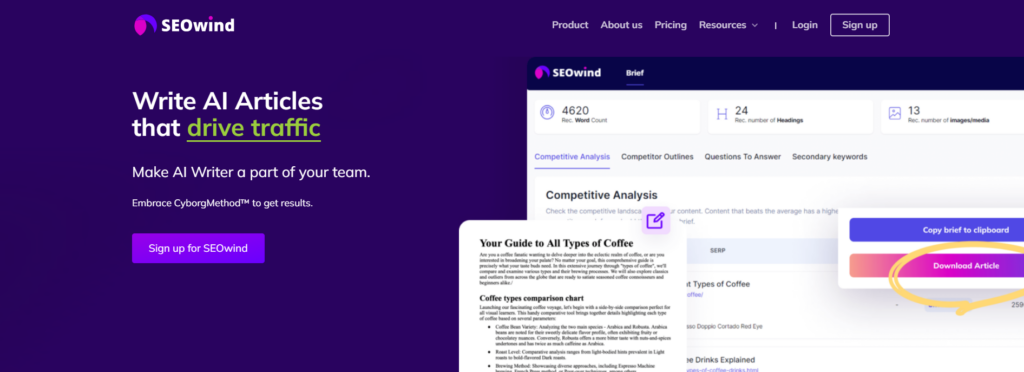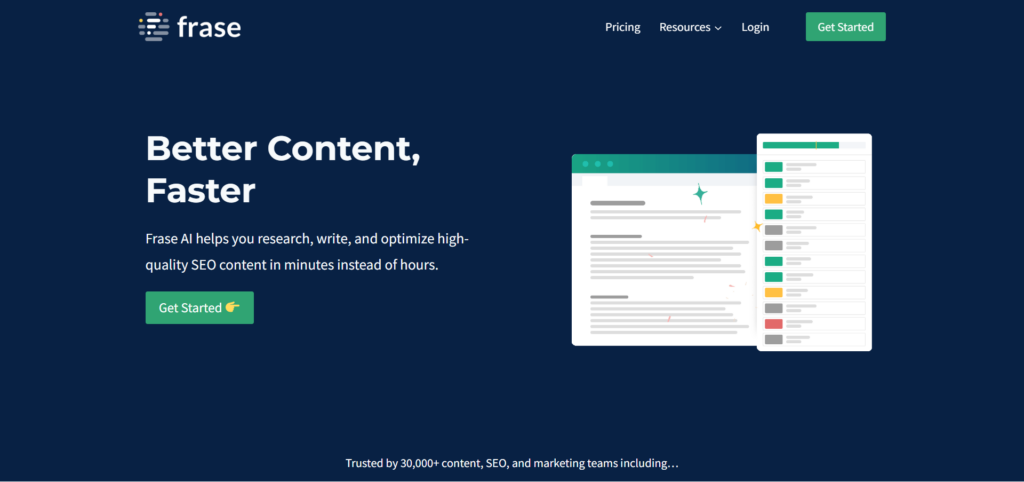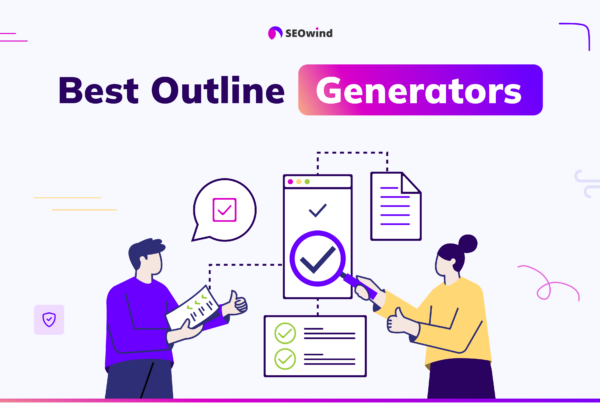Creating great content isn’t easy. It’s a skill that requires a lot of practice and hard work.
That’s why it’s important to have tools and templates that can help make the process easier.
In this blog post, we’ll share some of the best content brief templates and examples to help you create great content. We’ll also provide tips on how to use these templates effectively. So, if you’re looking to create better content, keep reading!
TL;DR
- Content brief templates outline all the key information about a piece of content you’re going to write.
- The template provides a structure for content writers to follow as they develop content, and ensures that all stakeholders are on the same page regarding the purpose and goals of the content.
- SEO content brief templates are a more strategic approach to creating the roadmap for your content. They focus not only on creating value for the reader but also on building the content to generate traffic.
- Using content briefs might be particularly helpful when you want to create a lot of standardized written content, start delivering content with a new freelance writer or an agency partner, avoid handling a lot of editing requests and rewrites, produce content at a fast speed with consistent quality, or have a content marketing strategy that generates predictable results.
- Using a content brief template can save time, optimize workflow, create better content, and improve consistency.
- To maximize the benefits of a content brief template, keep it simple, informative, and organized with clearly defined sections and headers for major points/topics.
- Use tools like SEOwind to speed up the process and maximize the time invested in creating each brief.
What is a Content Brief Template?

A content brief template is simply a document that outlines all the key information about a piece of content you’re going to write. This can include things like the topic, the tone of voice, the target audience, the desired outcome, and any other relevant details.
A content brief template is a great way to organize your thoughts and plan out your content before you start writing. It can be helpful to think of it as a road map for your content.
It provides a structure for content writers to follow as they develop content, and ensures that all stakeholders are on the same page regarding the purpose and goals of the content. The template includes questions and topics that content creators must answer in order to develop a clear and effective piece of content that resonates with their target audience..
By taking the time to fill out a content brief template, you can save yourself time and hassle later on.
Do you know the saying about chopping down the tree and sharpening the axe? So it goes!
“If I had five minutes to chop down a tree, I’d spend the first three sharpening my axe.”
This is what we mean.
The content brief template can help content creators optimize their workflow and save time. By having all of the necessary information in one place, content creators can avoid spending hours researching and planning their content. Ultimately, the content brief template is an essential tool for any content creator who wants to produce high-quality content efficiently.
Besides, it also saves time on rewrites and changes once the article draft is provided.
In short, a content brief template will help you produce better content, faster.
What is an SEO Content Brief Template
You can treat SEO Content Brief Template as a content brief on steroids. It’s a more strategic approach to creating the roadmap of what you’re going to write, focusing not only on creating value for the reader but also building it in such a way so that it generates traffic.
The process of creating such a template starts with looking into top SERPs, their content, and the keywords they rank for. By taking it from there you can make a comprehensive search-engine-optimized content brief template.
SEO Content Brief Template Example [Infographic]
To help you get started, we’ve created an SEO Content Brief Template Example infographic that you can use as a guide to creating compelling, search-engine-optimized content that resonates with your audience.

Content Brief Template – is it worth using one?
Yes, yes, yes.
The content brief template makes you focus on what is important. It’s like a checklist that guides you toward your goal.
It’s great to experience a writing flow and get creative. So if you are writing just for that you don’t need a template. You can go with the flow.
However, if you want the content to be found, if you want it to create great value for your audience, and if you want to drive traffic through the articles you’re writing, it’s not only an art. It’s a science. And template can bring you closer to that.
When to use a Content Brief Template?
So you’ve been asked to write a content piece, and you’re not sure where to start. Or maybe you’ve written content before, but you’re looking for a way to streamline the process. Either way, using a content brief template can be a helpful way to get organized and make sure you’re covering all your bases.
When should you use a content brief template?

Any time you’re starting a new writing project, it can be helpful to sit down and fill out a content brief template. This will help you to focus your thoughts and make sure you’re clear on what’s expected of you. And if you ever find yourself feeling stuck or lost during the writing process, refer back to your content brief template – it may just give you the inspiration or clarity you need to move forward.
There are a few different content types that a content brief template can be useful for blog posts, social media posts, eBooks, and email content.
Using content briefs might be particularly helpful when you want to:
- create a lot of standardized written content, e.g., blog posts, whitepapers, articles, etc.,
- start delivering content with a new freelance writer or an agency partner,
- handling a lot of editing requests and rewrites,
- produce content at a fast speed with consistent quality,
- have a content marketing strategy that generates predictable results.
The Benefits of Using a Content Brief Template

The idea here is that once you’ve got your content brief template down pat, all future briefs will be a breeze.
You can just grab one of these and apply it without issue each time there’s new content to create. Once you have the framework, the process goes quickly, too.
Reducing Content Production Costs by Providing Clear Guidelines for Writers
Every company aims to optimize its spending while maximizing quality output, right? Adopting an effective SEO content brief template is one practical way to achieve this in your content production workflow.
How so?
Well, when writers have clear guidelines before articulating via the template, it curbs misunderstandings or ambiguities. Writers become more efficient, and less time is spent on endless revisions or rewrites.
In other words, having a comprehensive SEO brief example significantly reduces project management overheads. It streamlines the production process – resulting in cost savings!
Ensuring Consistency Among Writers by Providing a Standard Format for Content Creation
Suppose you’re involved in running a blog or managing website content with multiple contributors. In that case, maintaining consistency can pose quite a challenge. A defined SEO brief template is an unbeatable solution here.
Why?
It offers every writer working on your projects the same structured format and expectations to follow. If everyone’s using the same playbook, variations in writing style, formatting preference, or article structure are minimized.
It’s like creating an orchestra where everyone knows their lyrics and tune; harmony becomes inevitable!
Improving Content’s Search Rankings by Targeting Relevant Keywords and Optimizing Content
Whether you’re whipping up a blog post or crafting an informative guide, chances are you want it to rank high on search engine results pages (SERPs). That’s where our hero – the SEO content brief template – steps in.
Encompassing keyword planning and optimization strategies within your content marketing brief helps writers create content that resonates with readers and plays nicely with Google’s ranking algorithms.
Simply put, optimized content gets more visibility, attracting more organic traffic – a win-win situation for your business and audience.
Meeting Delivery Deadlines by Providing a Structured Outline and Timeline for Content Creation
Meeting deadlines – the inevitable endgame of any project. I’m sure you’ve been there, anxiously watching the clock tick towards the delivery time of a piece of content. An SEO content brief template can be your secret weapon to avoid such nerve-wracking situations.
The step-by-step structure outlines what’s expected and when it’s due. This road map eliminates guesswork from the writer’s desk and keeps everyone on track with their timelines.
So, no last-minute rush, no missed deadlines—just smooth sailing through every content writing brief!
When using a Content Brief Template can be helpful
A content brief can help you create:
- High-quality, engaging articles
- Engaging blog posts
- Webpage content that is SEO-friendly
- Insightful infographics
- Educational videos
- And more!
Content brief is essential not only for content managers but also for content writers themselves.
Content writer perspective
A content brief template can help provide structure and organization for your content creation process. It can also help to ensure that all of the important details are included in your content piece.
If you find yourself struggling to come up with ideas for your content, a content brief template can also give you a jump start. By having a specific prompt to work from, you can get your creative juices flowing and come up with some great ideas for your next piece of content
Content manager perspectives
A content brief template can be beneficial if you work with a writers or content creators team. By having a content brief template, everyone will be on the same page as far as what needs to be included in the final piece

What to include in SEO Content Brief Template
An effective SEO content brief template should contain certain crucial components guiding content creation. These components streamline the writing process, from topic selection to final copy. Let’s delve into its key elements.
Primary Keyword Selection: How to Choose the Most Relevant Keyword for Your Content
Selecting the right primary keyword is essential in creating a content marketing brief that aligns with your SEO goals. The chosen keyword should encapsulate your core message while addressing user search intent on search engines.
- First, use tools like Google’s Keyword Planner or Moz’s Keyword Explorer to determine relevant terms to your topic.
- Secondarily, consider related phrases or questions users may ask about this topic – these can serve as additional keywords.
- Finally, prioritize these keywords based on their search volume and competition level.
By steadily weaving such carefully selected words into your piece naturally, you increase its chances of ranking higher in SERPs when users search for those specific terms.
Secondary keyword / Topics
Top Search Engine Result Pages rank not for one focus keyword but often for dozens of them. List all the topics and secondary keywords relevant to the content you’re writing to expand your reach.
Target Audience Identification: Understanding the Needs and Preferences of Your Audience
The next component touches upon identifying who our ideal reader is – understanding their needs, preferences, values, and what motivates them. This knowledge positions us to tailor our content efficiently in a way that resonates with the reader, thus fulfilling his/her informational needs.
Consider factors like:
- Demographics such as age, gender, location
- Interests/hobbies
- Pain points
- Their stage in the buyer’s journey
Creating a content writing brief template tailored towards a specific target persona not only aids emotional connection but also ensures readability by using language they easily comprehends.
Formatting Guidelines: Determining the Structure and Design of Your Content
Interactive content facilitates better engagement with readers. Hence, there needs to be an eye toward structuring and formatting the content to make it easy to digest. As a rule of thumb, a skim-friendly structure comprising short paragraphs, subheadings, bullet lists, and infographics goes a long way in retaining the reader.
Ensure your SEO content brief template incorporates detailed guidelines for breaking down complex information into manageable chunks. This way, writers can deliver concise and clear content easily understood by readers at all levels.
Brand Voice and Writing Style: Maintaining Consistent Brand Messaging through Content
Lastly but nonetheless important, maintaining a consistent brand voice and writing style throughout your content helps foster recognition among consumers while cementing credibility. Your audience should be able to identify your brand’s persona from your formal/professional or casual/conversational tone.
To nail this element in your brief content, pen down adjectives that best describe your brand’s voice, e.g., authoritative yet conversational, informative but engaging. Also, share examples of the desired tone with writers to guide them in replicating this voice accurately.
Remember consistency in communicating values across all platforms as this cultivates trustful relationships with consumers – one where they feel like you understand their needs personally, thus choosing to stick around longer on your platforms.
Incorporating these elements into a content brief template guarantees a purpose driven piece – giving due diligence to user intent and SEO objectives.
Suggested Word Count: Setting an Appropriate Length for Your Content Based on Its Purpose
How long should your masterpiece be? It sounds like a simple question. However, determining the suggested word count depends largely on the purpose and audience of your content. A well-executed content brief template should guide writers with recommended lengths for articles, blog posts, or social media updates rooted in clear strategic reasoning.
- For blog posts aiming to rank high in SERPs (Search Engine Results Pages), objective studies suggest an ideal length of around 1600 words.
- Infographics and similar visually driven assets might warrant shorter ‘supporting’ text—perhaps 300 words.
- Deep-dive analytic reports or whitepapers need substantially more space; anywhere from 2000 up to possibly 10k+ words might be necessary.
Always align your word count with purpose, audience expectations, and SEO best practices.
Content Outline: Structuring Your Content to Provide a Logical Flow of Information
A well-laid-out path leads content creators successfully from an eye-catching introduction to a satisfying conclusion. Precise outlines act as guiding lights through expansive fields of ideas—the “Google Maps,” if you like, charting direct routes through knowledge landscapes.
Your outline should:
- Highlight key points or arguments
- Include potential subheadings
- Suggest relevant transition phrases
- Indicate where visual aids can amplify the reader understanding
This schematic communicates what needs writing about and how ideas interconnect elegantly.
Competitor Examples: Analyzing Competitor Content to Identify Opportunities for Improvement
Examining competitor work isn’t spying—it’s savvy! Juxtaposing their strengths against your brand helps to uncover creative ways your content can shine brighter. Your SEO content brief template should include directions for writers to analyze competitor examples and extract key learnings.
Writers can observe factors such as:
- Language style and tone
- Types of embedded media (videos, infographics)
- Engagement metrics (likes, shares, comments)
- Backlink quality
External Links: Incorporating Authoritative Sources to Support Your Content
Your high school essays were never complete without bibliographies because teachers understood this gold nugget—solid references boost credibility! Embedding external links from authoritative sources subtly indicates thorough research and respect for intellectual transparency. This enriches the readers’ experience and facilitates better search engine rankings.
A good rule of thumb is to aim for at least 2-3 credible external links per page to expand the reader’s horizon.
Sub-topics: Breaking down Your Main Topic into Smaller Sections for Better Organization
Attempting to swallow large bites of information can lead readers to ‘intellectual indigestion.’ Assisting digestion requires neatly slicing main topics into positively palatable sub-topics. These smaller sections help writers organize their thoughts more comprehensibly while catering to online reading habits, favoring shorter blocks of text. This organizational strategy creates a clear path through complex concepts, making them more accessible and enjoyable for your audience.
In our writing journey today, we’ve navigated five critical components of constructing an effective SEO content brief template. By giving thoughtful attention to each element—from word count down to sub-topics—you stand poised, ready to craft compellingly readable and exquisitely optimized material. Dive in confidently!
Additional information that can be included in the SEO Content Brief Template
Due Date
When you expect the content to be delivered,
Intended result
This ensures that your content is effective and meets your marketing needs. Decide what the goal of the content you’re creating is. Is it generating traffic, building brand awareness, or maybe generating leads?
Brand voice
Defining brand voice ensures that the content will be aligned with communication and language of your brand.
Content type
Define the type of content the brief concerns. Is it a blog post, expert article, landing page, whitepaper, ebook, or another type of copy?
Content Title
The title should be catchy and include the keywords you’re targeting. It should also be relevant to your topic, and it should be short enough so that it can be easily read on a page without taking up too much space.
SEO Meta description
It’s a brief description of your page that is shown in the search engine results pages (SERPs). You must include keywords in your meta description so that your page will show up when people are searching for information about that topic.
URL slug
It is worth adding a website slug If you have any recommendations regarding it.
Should Your Content Brief Template Include an Outline?
As a content writer, you might be wondering if your content brief should always include an outline. The answer is that it depends on the scope of the project. For some projects, an outline is essential in order to ensure that all of the necessary information is covered. For other projects, an outline might be helpful but not strictly necessary.
When an Outline Is Necessary
If you’re writing a long-form piece of content, such as a comprehensive blog post, an eBook, or a white paper, then it’s definitely worth including an outline in your brief. This is because a long-form piece of content needs to be carefully structured in order to keep the reader’s attention focused throughout. An outline will help you to organize your thoughts and figure out what information needs to be included in each section.
Another situation when you might want to consider including an outline is if you’re writing about a complex topic that requires a lot of explanation. In this case, an outline can help to make sure that you cover all of the key points without getting too bogged down in the details.
When an Outline Isn’t Necessary
Some say that if you’re only writing a short blog post or article, then there’s no need to include an outline in your brief. This is because a short piece of content doesn’t need to be as carefully structured as a longer one. As long as you have a clear idea of what you want to write about, you should be able just to start writing and see where the piece takes you.
Still, in my experience, it is worth writing the outline whenever you’re creating content. It makes the whole process better organized and efficient.

3 Effective SEO Content Brief Templates and Samples with Outline Examples
Now the templates you’ve been waiting for. We created a couple of them using SEOwind – a tool for generating SEO content briefs – to show you what a comprehensive SEO content brief should look like.
Are there any coffee lovers here? I’ll base the content briefs on keywords related to brewing coffee and coffee types.
#1 Article SEO Content Brief Template
Let’s create a brief for writing an article or a blog post. We’ll write an SEO Content Brief for the primary keyword “how to brew coffee at home”.
Based on the data generated from SERPs (competitive analysis, competitor outlines, questions to answer, and secondary keywords), we’ve compiled this brief in no more than 10 minutes.
Once the content brief is ready you can either copy-paste it to the document or share it directly with your content writer.
On top of that, we’re adding your brand voice, company and product information, and relevant stats and quotes.
Click the link to see what the word content brief example looks like.
#2 Website Content Writing Brief Template
Content briefs can be used not only to write articles or other long-form content. They are also a great source of inspiration when creating websites like landing pages. This time, let’s look at a Content Writing Brief for a more product-oriented keyword like “Chemex coffee maker.”
Click the link to see what the landing page content brief template looks like.
#3 SEO Content Brief Example
Let’s take a look at another example of an SEO content brief, this time for a keyword: types of coffee.
Click the link to see what the content brief template looks like.
Content Brief Templates
If you would like to create content with SEOWind content brief templates, just create SEOwind account.
How To Automate Your Content Brief Templates
The content brief generator can be an invaluable tool for any content marketer or marketing manager aiming to generate organic traffic.
It automates and streamlines the creation of content brief templates, enabling businesses to create high-quality briefs that meet their requirements quickly.
With a content brief generator, you no longer need to spend hours manually creating a content brief. Just provide us with your focus keyword and the generator produces a polished brief for them to use. This makes content creation easier, faster, and more efficient, allowing businesses to focus their resources on other areas. Additionally, this type of automation also saves companies time and money by eliminating the need to create briefs or hire outside help manually. Content brief generators can be an essential part of any business’s content strategy.
For more information on Content Brief Generators go to How to create a Content Brief with Content Brief Generator
Overview of tools available for creating SEO Content Briefs

Several cutting-edge platforms offer innovative ways to assist in crafting well-detailed content briefs. So, let’s take a closer look at three award-winners – SEOwind, Marketmuse, and Frase – who have earned their spots on every content marketer’s radar due to their intuitive interfaces and reliable results.
SEOwind – Generating SEO-Optimized Content Briefs

Are you ready for some wind beneath your wings? Enter – SEOwind. This SEO Content Brief Generator generates dust-whipping, hot-off-the-races content briefs primed for optimum search engine results.
SEOwind helps you:
- Research great content quickly – Get all the data on top-ranking SERPs, keywords, and questions in one place
- Create Content Outline with a couple of clicks – Build your comprehensive outline in minutes. Within 10 minutes you’ll have a content brief that is objectively better than your competitors.
- Discover highly relevant keywords – Write content that ranks not for one keyword but for dozens of keywords.
- Take advantage of powerful AI – We use AI to generate automated SEO content briefs – relevant, and comprehensive, based on tons of SEO data which keeps AI on track for nailing the search intent.
- Answer the right questions – Deliver value to your audience by answering their questions and addressing their pains and needs.
- Get your content structure right – Create content that stands a fight with top SERPs. Base it on data, not hunch.
- Easily share with the content writer – Once your brief or content outline is complete, you can share the link directly with your content writer.
Imagine being handed over keys to unlock the treasure chest of visibility on SERPs (Search Engine Results Pages). The keyword suggestions aren’t just based on a guessing game but data-driven research, ensuring your SEO efforts don’t go unnoticed.

Moreover, it helps seamlessly cluster related keywords together, simplifying topic modeling while keeping up with the latest SEO trends and strategies. With the valuable insights SEOwind provides, you will be well-equipped to dominate your niche markets.
MarketMuse: In-depth research on topic relevance and competition

MarketMuse uses artificial intelligence to streamline several aspects of the SEO grooming process. It excels at conducting extensive research regarding topic relevance and competition – pivotal elements for establishing authority and improving SERP rankings. When generating an SEO brief example using Marketmuse, it employs an AI-driven approach to pinpoint pertinent keywords while offering insights about direct competitors’ performance within similar topics.
The excellent features come bundled with a friendly user interface user interface, simplifying data interpretation even for beginner-level users. Its pricing may be prohibitive to smaller organizations or those just beginning their adventure into optimized content creation.
Frase: Generating organized outlines & optimizing for key terms

Frase positions itself as more than a tool – it’s your personal content creation assistant, endeavoring to simplify drafting an SEO brief template. Frase does this by generating comprehensive outlines and optimizing for target terms immediately.
Its prominent feature is primarily capable of outlining drafted articles while highlighting key ideas or sub-topics needed for a full-bodied attribution. It optimizes each segment around pertinent keywords, ensuring you deliver rich content that captures attention and propels you up in SERPs.
Final thoughts
The best way to ensure that you are creating great content is to use a content brief template as a guide. This will help you to organize your thoughts and ensure that you are covering all of the key points that you want to make. In addition, it can be helpful to look at examples of great content so that you have a model to follow. By using these resources, you should be able to create content that stands out from the competition and engages your audience.
What tips do you have for creating great content? What works best for you?


